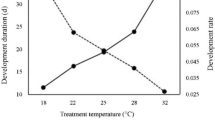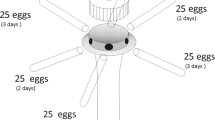Summary
Three species ofAphytis parasites of California red scale,Aonidiella aurantii (Maskell) were each confined at different densities with approximately equal numbers of scale insects at several constant temperatures to determine the effect of these factors on progeny production and distribution and the search rate. Egg location on the host body by the parasites was unaffected by temperature or parasite density.A. melinus laid its eggs both dorsally and ventrally in equal proportions whileA. lingnanensis andA. chrysomphali laid their eggs ventrally.
Progeny production byA. melinus andA. lingnanensis increased at the higher temperature; that ofA. chrysomphali did not. Unlike the other species,A. chrysomphali failed to oviposit at 32°C.
Although increasing parasite density reduced progeny production in bothA. melinus andA. lingnanensis, they were able to maintain an almonst constant search rate. This was due to their ability to distribute their eggs among the hosts more regularly at the higher parasite densities. While the mechanism of this process is easy to understand forA. melinus which behaved as a gregarious parasite, it is unclear forA. lingnanensis, which is almost a solitary parasite. The progeny production and the search rate ofA. chrysomphali dropped significantly with increasing parasite density.
Similar content being viewed by others
References
Abdelrahman, I. (1974) Growth, development and innate capacity for increase inAphytis chrysomphali Mercet anda. melinus DeBach, parasites of California red scale,Aonidiella aurantii (Mask.), in relation to temperature.Aust. J. Zool. 22: 213–230.
Benson, J. F. (1973) Intraspecific competition in the population dynamics ofBracon hebetor Say (Hymenoptera: Braconidae).J. Anim. Ecol. 42: 105–124.
DeBach, P. (1971) Fortuitous biological control from ecesis of natural enemies. 293–307. InEntomological Essays to Commemorate Prof. I. Yasumatsu. Hokuryukan Publ. Co. Ltd. Tokyo.
DeBach, P. andP. C. Sisojevic (1960) Some effects of temperature and competition on the distribution and relative abundance ofAphytis lingnanensis andA. chrysomphali (Hymenoptera: Aphelinidae).Ecology 41: 153–160.
DeBach, P. andR. A. Sundby (1963) Competitive displacement between ecological homologues.Hilgardia 34: 105–166.
DeBach, P. andE. B. White (1960) Commercial mass culture of the California red scale parasiteA. lingnanensis. Bull. Calif. Agric. Exp. Sta. No. 770.
DeBach, P., D. Rosen andC. E. Kennet (1971) Biological control of coccids by introduced natural enemies. 165–194. InC. B. Huffaker (ed)Biological Control, Chapter 7. Plenum Press, New York.
Griffiths, D. (1977) Models for avoidance of superparasitism.J. Anim. Ecol. 46: 59–62.
Hasell, M. P. (1978)The dynamics of arthropod predator-prey systems. Princeton University Press, Princeton.
Hassell, M. P. andG. C. Varley (1969) New inductive population model for insect parasites and its bearing on biological control.Nature 223: 1133–1137.
Kfir, R. andR. F. Luck (1979) Effects of constant and variable temperature extremes on sex ratio and progeny production onAphytis melinus andA. lingnanensis (Hymenoptera: Aphelinidae).Ecological Entomology 4: 335–344.
Kfir, R., H. Podoler andD. Rosen (1975) Presence of males increases the area of discovery of a gregarious parasitoid.Ann. ent. Soc. Am. 68: 707–709.
Kfir, R., H. Podoler andD. Rosen (1976) The area of discovery and searching strategy of a primary parasite and two hyperparasites.Ecological Entomology 1: 287–295.
Lenteren, J. D. van andK. Bakker (1976) Functional responses in invertebrates.Neth. J. Zool. 26: 567–572.
Lenteren, J. D. van andK. Bakker (1978) Behavioral aspects of the functional responses of a parasite (Pseudocoila bochei Weld) to its host (Drosophila melanogaster).Neth. J. Zool. 28: 213–233.
Luck, R. F., H. Podoler andR. Kfir (1982) Host selection and egg allocation behaviour byAphytis melinus DeBach andA. lingnanensis Compere: comparison of two facultatively gregarious parasitoids.Ecological Entomology 7: 397–408.
Luck, R. F., J. C. van Lenteren, P. H. Twine, L. Keunen andT. Unruh (1979) Prey or host searching behavior that leads to a sigmoid functional response in invertebrate predators and parasitoids.Res. Popul. Ecol. 20: 257–264.
Platner, G. R., G. J. Scriven andC. E. Braniger (1973) Modification of a compact refrigerator for bio-ecological studies under controlled physical parameters.Environ. Entomol. 2: 1118–1120.
Podoler, H., D. Rosen andM. Sharoni (1978) Ovipositional response to host density inAphytis holoxanthus (Hymenoptera: Aphelinidae), an efficient gregarious parasite.Ecological Entomology 3: 305–311.
Remington, C. L. (1968) The population genetics of insect introduction.Ann. Rev. Entomol. 13: 415–426.
Rogers, D. (1975) A model for avoidance of superparasitism by solitary insect parasitoids.J. Anim. Ecol. 44: 623–638.
Rogers, D. J. andM. P. Hassell (1974) General models for insect parasite and predator searching behavior: interference.J. Anim. Ecol. 43: 239–253.
Rosen, D. andP. DeBach (1979)Species of Aphytis of the world (Hymenoptera: Aphelinidae). Israel Universities Press, Jerusalem.
Author information
Authors and Affiliations
Rights and permissions
About this article
Cite this article
Kfir, R., Podoler, H. Effect of temperature and parasite density on three species ofAphytis (Hymenoptera: Aphelinidae), parasitising California red scale. Res Popul Ecol 25, 69–80 (1983). https://doi.org/10.1007/BF02528784
Issue Date:
DOI: https://doi.org/10.1007/BF02528784




